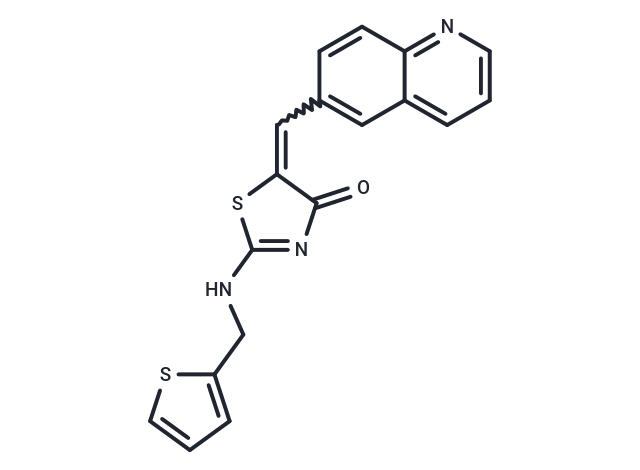Shopping Cart
- Remove All
 Your shopping cart is currently empty
Your shopping cart is currently empty

RO-3306 is a selectivity ATP-competitive CDK1 inhibitor (Ki: 20 nM). The selectivity of RO-3306 for CDK1 is >15-fold higher than a diverse panel of human kinases.

| Pack Size | Price | Availability | Quantity |
|---|---|---|---|
| 1 mg | $32 | In Stock | |
| 5 mg | $68 | In Stock | |
| 10 mg | $93 | In Stock | |
| 25 mg | $158 | In Stock | |
| 50 mg | $228 | In Stock | |
| 100 mg | $372 | In Stock | |
| 200 mg | $549 | In Stock | |
| 500 mg | $869 | In Stock | |
| 1 mL x 10 mM (in DMSO) | $75 | In Stock |
| Description | RO-3306 is a selectivity ATP-competitive CDK1 inhibitor (Ki: 20 nM). The selectivity of RO-3306 for CDK1 is >15-fold higher than a diverse panel of human kinases. |
| Targets&IC50 | PKCδ:318 nM(Ki), ERK:1980 nM(Ki), SGK:497 nM(Ki), CRC401 cells (primary rectal tumor):5258 nM, SKOV3 cells:16.92 µM, HEY cells:10.15 µM, CDK2-CyclinE:340 nM (Ki), CDK1-CyclinA:110 nM (Ki), CRC057 (liver metastasis) cells:2317 nM, CDK1:20 nM(Ki), CRC240 (liver metastasis) cells:3312 nM, CDK1/cyclinB1:35 nM (Ki), CDK1-CyclinB1:35 nM (Ki), CRC247 (liver metastasis) cells:6303 nM, CRC16–159 (primary colon tumor) cells:3503 nM, CDK2/cyclinE:340 nM (Ki), CRC119 (liver metastasis) cells:3268 nM |
| In vitro | METHODS: OVCA-429 and OVCAR-3 ovarian cancer cells were treated with Ro 3306 (1-2.5 nM) for 9 days, and cell viability was measured using crystal violet assay. RESULTS: OVCA-429 and OVCAR-3 cells showed low growth rates at high dose concentrations of Ro 3306 for up to 9 days. Treatment with 2.5 µM Ro 3306 reduced the growth rate of OVCA-429 and OVCAR-3 cells by 75.3% and 87.7%, respectively, on day 9. [1] METHODS: Human tumor cell lines HCT116, SW480 and HeLa were treated with Ro 3306 (9 µM) for 20 h. Cell cycle was detected by Flow cytometry. RESULTS: Treatment of proliferating human tumor cells with Ro 3306 for 20 h resulted in complete G2/M cell cycle arrest. [2] |
| In vivo | In HCT116, SW480, and HeLa cell lines, treatment with RO-3306 for 20 hours resulted in a complete cell cycle arrest at the G2/M phase. RO-3306 (10 μM) effectively inhibits oocyte maturation. The compound demonstrates inhibition of CDK1/cyclin B1 (Ki: 35 nM), CDK1/cyclin A (Ki: 110 nM), CDK2/cyclin E (Ki: 340 nM), and CDK4/cyclin D (Ki>2000 nM) activities. Additionally, RO-3306 significantly impedes the proliferation of HCT116 and SW480 cells. Compared to non-tumorigenic cells (MCF 10A and MCF 12A), RO-3306 exhibits a stronger pro-apoptotic effect on cancerous cells (HCT116 and SW480). |
| Kinase Assay | CDK assay: The activity of CDK1 cyclin B1, CDK1 cyclin A, CDK2 cyclin E, and CDK4 cyclin D is measured by a homogeneous time-resolved fluorescence assay in a 96-well format. The assay buffer contained 25 mM Hepes, 6.25 mM MgCl2, 0.003% Tween 20, 0.3 mg/mL BSA, 1.5 mM DTT, and ATP as follows: 162 μM (CDK1), 90 mM (CDK2), or 135 μM (CDK4). CDK1 and CDK2 buffer contained 10 mM MgCl2. Test compounds are diluted in assay buffer to 3-fold their final concentration in 20 μL, and the reaction is started by the addition of a 40 μL assay buffer containing the pRB substrate (0.185 μM). The plates are incubated at 37°C for 30 min with constant agitation, and the reaction is terminated by the addition of 15 μL of 1.6 μM anti-phospho pRB antibody (Ser-780) in 25 mM Hepes, 24 mM EDTA, and 0.2 mg/mL BSA. After an additional 30 min of incubation with shaking, 15μL of 3 nM Lance-Eu-W1024-labeledanti-rabbitIgG and 60 nM Alophycocyanin-conjugated anti-His-6 antibody in 25 mM Hepes, and 0.5 mg/mL BSA is added and incubated for 1 h. The plates are read in the Victor-V multi- label reader at excitation 340 nm and emission 615 nm and 665 nm. The IC50 values are calculated from the readings at 665 nm and normalized for Europium readings at 615 nm. Ki values are calculated according to the equation: Ki= IC50/(1 + S/Km ), where S is the ATP concentration in the assay and Km is the Michaelis-Menten constant for ATP. The inhibitory activity against the panel of kinases is determined by the IMAP assay technology. |
| Cell Research | Log phases cells (25,000) are seeed in 96-well plates and incubated in a 37℃ incubator with CO2, After 24 h, different concentrations of RO-3306 are administered to determine the drug concentrations required to achieve a 50% growth inhibition (IC50). MTT (20 μL, 5 mg/mL stock solution in saline) is added to each well and the cells are incubated for 4 h. Supernatants are removed and formazan crystals from viable cells are solubilized with 200 μL anhydrous DMSO. The absorbance is detected with a 550 model microplate reader at the 565 nm wavelength.(Only for Reference) |
| Molecular Weight | 351.45 |
| Formula | C18H13N3OS2 |
| Cas No. | 872573-93-8 |
| Smiles | O=C1N=C(NCc2cccs2)SC1=Cc1ccc2ncccc2c1 |
| Relative Density. | 1.41 g/cm3 |
| Storage | Powder: -20°C for 3 years | In solvent: -80°C for 1 year | Shipping with blue ice/Shipping at ambient temperature. | |||||||||||||||||||||||||
| Solubility Information | DMSO: 12.5 mg/mL (35.57 mM), Sonication is recommended. | |||||||||||||||||||||||||
| In Vivo Formulation | 10% DMSO+40% PEG300+5% Tween 80+45% Saline: 1.25 mg/mL (3.56 mM), Solution. Please add the solvents sequentially, clarifying the solution as much as possible before adding the next one. Dissolve by heating and/or sonication if necessary. Working solution is recommended to be prepared and used immediately. The formulation provided above is for reference purposes only. In vivo formulations may vary and should be modified based on specific experimental conditions. | |||||||||||||||||||||||||
Solution Preparation Table | ||||||||||||||||||||||||||
DMSO
| ||||||||||||||||||||||||||

Copyright © 2015-2025 TargetMol Chemicals Inc. All Rights Reserved.